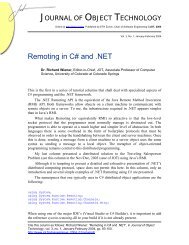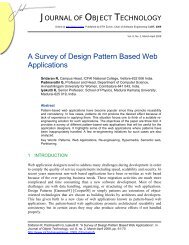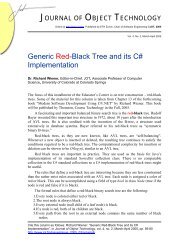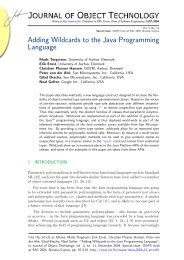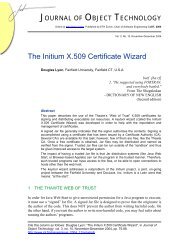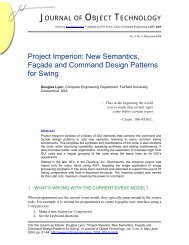Extension of Object-Oriented Software Testing Techniques to Agent ...
Extension of Object-Oriented Software Testing Techniques to Agent ...
Extension of Object-Oriented Software Testing Techniques to Agent ...
Create successful ePaper yourself
Turn your PDF publications into a flip-book with our unique Google optimized e-Paper software.
EXTENSION OF OBJECT-ORIENTED SOFTWARE TESTING TECHNIQUES TO AGENTORIENTED SOFTWARE TESTINGaccomplish the desired tasks by collaborating with other agents. There are very fewliterature that describe s<strong>of</strong>tware testing for agents. The simulation approach suggested byHimmelspach et al. can be utilized <strong>to</strong> test the behavior <strong>of</strong> the agent system interactingwith environment [Himmelspach]. The virtual environment is used in contrast <strong>to</strong> the realtime environment because it will reduce the cost and effort involved. Since theenvironment changes dynamically, we need <strong>to</strong> moni<strong>to</strong>r the agents at each point <strong>of</strong> time.JAMES (Java based agent modeling environment for simulation), is the simulationsystem that is used for creating the virtual environments and generating the dynamic testcases. Nguyen et al. [Nguyen] suggested the goal testing approach based on troposmethodology. Goals are classified as mainley hard goal and s<strong>of</strong>t goal. Goals are executedby plans and a goal can have sub goal. Test cases are derived from goals.<strong>Agent</strong>s have higher level <strong>of</strong> abstraction as compared <strong>to</strong> objects. <strong>Agent</strong>s encapsulatemental state and behavior also. On the other hand, objects encapsulate data andalgorithm. <strong>Agent</strong>s can change their behavior according <strong>to</strong> the environment while objectscan perform only trained tasks. Each agent has its own thread <strong>of</strong> control whereas eachobject need not have its own thread <strong>of</strong> control. Even though the agents and objects havethe above mentioned differences, the modeling techniques used for analysis and design <strong>of</strong>object oriented techniques are being extended <strong>to</strong> support agent oriented s<strong>of</strong>twaredevelopment [Yim]. Hoongsoon Yim et al. has extended UML <strong>to</strong> support development <strong>of</strong>agent systems [Zied].An example <strong>of</strong> air ticket booking agent system is described in section two. Thisexample is used as a reference and the testing techniques are applied on that. Sectionthree and four discusses about the random testing and behavioral testing techniquesrespectively. Section five focusses on the partition technique at the agent level. The paperconcludes with a summary <strong>of</strong> the work and some suggestions for the potential futurework.2 AIR TICKET BOOKING AGENT SYSTEMThe paper presents the implementation <strong>of</strong> an agent based air ticket booking system usingJADE 3.5 (Java <strong>Agent</strong> Development Framework). JADE simplifies the implementation<strong>of</strong> multi-agent systems through a middle-ware that complies with the FIPA specificationsand through a set <strong>of</strong> graphical <strong>to</strong>ols that supports the debugging and deployment phases[Jade]. The agent platform can be distributed across machines (which not even need <strong>to</strong>share the same OS) and the configuration can be controlled via a remote GUI. Theconfiguration can be even changed at run-time by moving agents from one machine <strong>to</strong>another one, as and when required [Dam]. The air ticket booking system is a multi agentsystem comprising <strong>of</strong> buyer and a seller agent. The seller agent registers with the servicedirec<strong>to</strong>ry. The buyer agent will read the flight details through the command line andsearch the corresponding seller agents which are satisfying the flight requirements. Thedirec<strong>to</strong>ry service maintains the list <strong>of</strong> all available sellers. Furthermore, the buyerreceives the proposals from all the seller agents and will select the seller with best price156 JOURNAL OF OBJECT TECHNOLOGY VOL. 7, NO. 8



